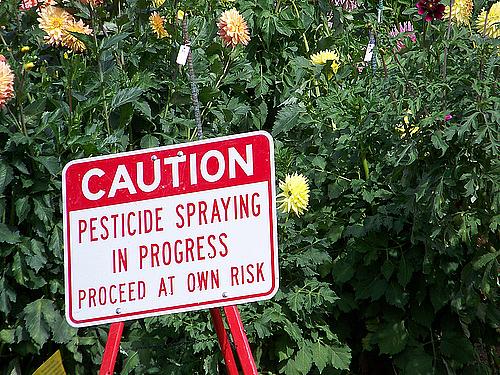Raising awareness about potential effects of pesticides, especially on farmworkers

Earlier this month, New York Times columnist Mark Bittman highlighted the mounting body of evidence - which has been growing since the publication of Rachel Carson’s ‘Silent Spring’ 50 years ago - that pesticides pose danger to all people.
“While Rachel Carson focused on their effect on ‘nature,’ it’s become obvious that farmworkers need protection from direct exposure while applying chemicals to crops,” Bittman wrote. “Less known are the recent studies showing that routine, casual, continuing - what you might call chronic - exposure to pesticides is damaging not only to flora but to all creatures, including the one that habitually considers itself above it all: us.”
One such study Bittman references found that “every human tested is found to have pesticides in his or her body fat. And because pesticides are found in nearly every stream in the United States, over 90 percent of wells, and — in urban and agricultural areas — over half the groundwater. So Department of Agriculture data show that the average American is exposed to 10 or more pesticides every day, via diet and drinking water,” he writes.
Late last week, I reached out to two experts at national organizations focusing on pesticides and asked them to respond to Bittman’s piece. Both praised him for bringing widespread attention to the issue and agreed with his assessment that we have a long way to go before we can establish pesticide-related policies and practices that truly protect people’s health.
Both also said that the people most vulnerable - including farmworkers, rural communities and their children - need to be better informed about and protected from the effects of pesticides.
“What Carson saw and sounded the alarm about is a situation still fundamentally intact: pesticides are still making us sick and poisoning our environment because those who are bearing the risks and harms are not the people making the decisions,” Paul Towers, organizing and media director at Pesticide Action Network North America, said in an e-mail. “In particular, farmworkers, rural communities and children are those on the frontlines of pesticide exposure and facing some of the greatest harms.”
Levy Schroeder, director of Health & Safety Programs at the Association of Farmworker Opportunity Programs, agreed that Bittman and other influential food writers have raised awareness about pesticides among the general population. But, Schroeder said in an e-mail, “[I]nformation about pesticides often targets consumers and disregards the population that has more pesticide exposure, day-in and day-out, than any other group in this country. Farmworkers are continuously omitted from the discussion about pesticides.”
These two organizations have succeeded in educating vulnerable communities about pesticides and channeling this knowledge into action.
Earlier this year, Pesticide Action Network North America - in collaboration with nonprofit litigators, scientists, grassroots coalitions, farmers and farmworkers - helped stop the sale of methyl iodide, a cancer-causing fumigant commonly used in strawberry fields. “The collaboration was effective because we were able to talk to enough people through the press and in our communities, so that Arysta, the manufacturer, pulled methyl iodide from the market,” Towers explained.
And the Association of Farmworker Opportunities Programs, in partnership with the EPA, has provided more than 550,000 migrant and seasonal farmworkers with a pesticide safety training program since 1996, Schroeder said. “Our curriculum has multi-lingual capability, sensitivity to low-literacy and cultural awareness that brings information about pesticides directly into the fields, orchards and nurseries,” she explained.
Despite these achievements, both generally agreed with Bittman’s conclusion that when it comes to pesticides: “Much damage has been done, and it’s going to get worse before it gets better.”
“The long-term solution is to reduce pesticide use, and the ways to do that include some of the typical laundry-list items that find their way into every ‘how to improve American agriculture’ story,” Bittman writes. That, he said, includes rotating crops; regulating pesticides better, with special attention paid to their impact on farmworkers, people of childbearing age, and women in their first trimester of pregnancy; giving farmers the option of using non-genetically engineered seeds; and moving toward using more organic farming principles.
Bittman also encouraged consumers to choose organic produce to reduce their pesticide exposure when possible, especially for the fruits and vegetables that the Environmental Working Group labels as the “Dirty Dozen.”
But the long-term solution should also include making consumers aware of pesticides’ impacts on farmworkers and farmworker communities, Schroeder said.
“Awareness needs to continue to be raised among the general public, not only about pesticides on the food we eat, but also the effect pesticides have on the 2.5 million men, women, and children who work in the fields,” she said. “Farmworkers suffer the consequences of long-term pesticide exposure as they work in the fields, experience acute pesticide poisoning when pesticide drift carries dangerous chemicals to where they are working, and worry about exposing their developing children to these chemicals as most farmworker housing is nearby agricultural fields,” she said.
Image by JetsandZepplins via Flickr

